It often happens that our desires go beyond our capabilities. And then it turns out that the idea of creating a house, a garden and several necessary outbuildings on a small plot faces objective difficulties: there is simply not enough space for everything planned. How, in this case, to decorate a modest space in order to realize what everything was started for? After all, the plot was purchased to get away from the city and be closer to nature. So let there be at least a mini garden.
The art of designing a mini garden is that the space increases, first of all, in the imagination of the person who is in it. You can’t make something small big, but you can and should make it so that the viewer gets the impression that there is a lot of space around him. This effect is achieved by different methods.

If you take a close look, you will find that this idyll with a pond and a gazebo does not take up as much space as it seems
Let's not hit the wall
First of all, you need to work with what physically limits the area of the allotted space - the fence. A blank and impenetrable fence creates a feeling of enclosure, turning a cozy courtyard into a box that is about to be closed with a lid. Therefore, it is better to use an openwork fence or decorate it with flowering climbing plants.

Until the plants grow, the fence will look too permeable, so some still prefer a solid fence
But sometimes, due to the proximity of neighboring buildings, the use of a “transparent” fence creates certain inconveniences. A possible way out in this case would be a fence with blinds. The space can be visually expanded only when the owner of the site has a need for it or until the climbing plants are covered with foliage.
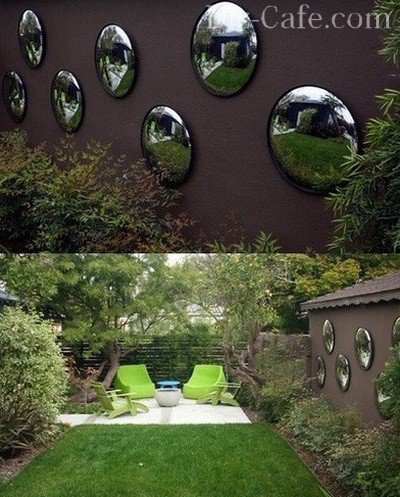
The amazing optical effect of the “dragonfly’s eye” allows you not only to visually expand the space, but also to gain a reputation as a conflict-free neighbor
Even the presence of a neighbor’s garage, the wall of which partially replaces the fence, will not be superfluous if you accept it as a full-fledged participant in your game with optical effects. Convex mirrors attached to this wall distort the reflection of the garden. The perspective they create is deeper than it actually is. Such “dragonfly eyes”, placed on a chocolate-colored wall, transform a small lawn into a fairly spacious lawn.
The secret of the right garden path
Science fiction writers love to use the technique of curved space, when an object that is small on the outside looks completely different from the inside. We will also try to bend space with the help of crooked garden paths. After all, if the path winds, then the journey along it will last longer. It seems to the walker that his path runs through a much larger area.

Garden paths running somewhere into the distance attract the eye of the observer, expand the space of your mini garden and look a little mysterious
If, where the space is clearly visible into the distance, you make transverse paths, and allow longitudinal paths to wind between flowerpots and behind bushes, the illusion of a greater width of the site will arise. If the path runs along a narrow strip of the garden, then you can paint the fence into which it abuts in its colors and cover its upper part with flowers. It will seem that the looping stitch right along the fence goes somewhere into the sky.

A neat path runs beyond our visibility, and an elegant arch entwined with abundant greenery turned out to be very useful here
Those leading “to nowhere” look especially fabulous. If the path leads the eye into dense greenery growing not far from the fence, then the observer’s deceived vision will form the impression that, in the place where the path ran away, the garden itself continues.
Mirror water surface
To prevent the walker from being able to fix his attention on contemplating the site as a single object, it is necessary to offer him new impressions. A magician works on the same principle, making distracting passes with his hands. The impressive little details and their charm distract from the fact that the area in which all this is located is extremely small.

The two most popular reservoirs for mini gardens are a small fountain near the wall and a pond on two levels with a bridge.
A great distraction is reflection. It has a mesmerizing effect. What can be used as a reflective surface in a small garden? The surface of the water is small! Such a reservoir will not take up much space. It could even be a stream running along the side of the site. Another option is a pond on two levels with a bridge across it. Your own reflection in water always attracts attention.
If the area is small, it is better not to use running water. The sound of falling water can be too intrusive. If, nevertheless, the idea of arranging a fountain or waterfall grabs you and won’t let you go, choose a place for it somewhere near the fence, be sure to coordinate your decision with your neighbors. After all, the constant sound of flowing water should not annoy them either.

One of the three phenomena that a person can look at indefinitely is considered to be flowing water. This secluded corner is designed to enjoy this spectacle to your heart's content.
Tree size doesn't matter
Even the smallest garden cannot do without trees. If you love big trees, the size of your plot shouldn't dictate your life rules. Do you want to plant a big tree? Let it be! Just imagine what delightful coolness its luxurious spreading crown will give you on a hot summer day. You can place a tree in the middle of the site, and plan a recreation area directly under it.

Who said that all plants in a small area, without exception, must be dwarf? This misconception can be easily dispelled
If you use a circular one, surrounding yourself with vegetation on all sides, even if it is just a fence entwined with greenery, you will get the impression of being in a large garden. The center of the garden offers an excellent overview: you can perfectly plan the “collapsed” space around you.

Here is the second placement option, in which a large tree will also not be superfluous. A relaxation area in the shade of its crown can become the most comfortable place in the entire garden.
Vertical gardening techniques
Of course, a garden cannot be greened with just one tree, albeit a large one. Not only will it help to turn it into a lush flowering corner right choice plants, but also a correctly applied planting method.
Particularly important for a modest-sized plot. To make walls of greenery, arches, garden trellises, fences, pergolas, facades and gazebo fences are used. Screens and trellises are the most common decorative elements when arranging mini gardens. They are used both as independent elements and in combination with flowerpots, flower beds and various garden accessories. They are also used to delimit individual zones of the site.
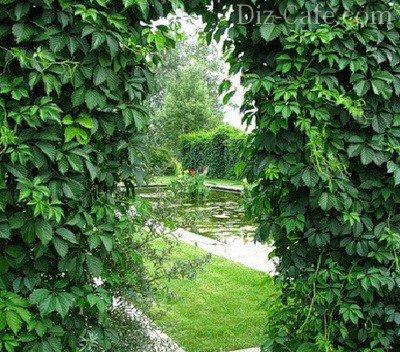
When using vertical gardening, it is very important to carefully select plants for this purpose, because hops, for example, can fill the entire area
Various varieties of wild grapes, decorative beans, hops, sweet peas, and clematis are suitable as plants. In order for all this wealth to be abundantly covered with greenery and flowers, many factors must be taken into account when planting: the condition of the soil, the amount of precipitation, shading, the prevailing wind direction and other features inherent in your site.
By the way, not only garden plants, but also garden plants can be used as greenery. Very interesting vertical gardens are created using. To avoid monotony in perception, it is better to use different plants.
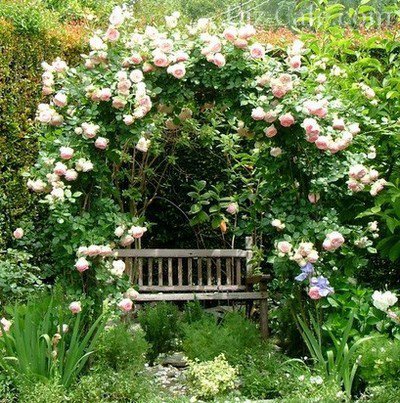
A bench in flowers is a popular design technique for expanding space, which makes an indelible impression on the viewer who sits on such a bench
Place an ordinary one near the fence and build a tall flowering arch entwined with roses directly above it. If you now sit down on this bench, you will have the complete feeling that a spacious garden extends around you, in the depths of which you are located. Techniques for creating a wild and slightly neglected garden are always effective in areas where space is limited.
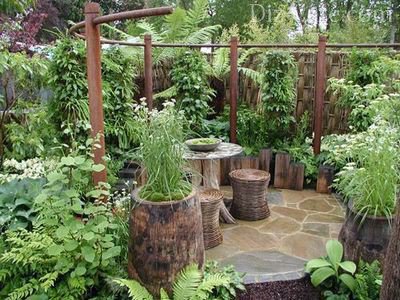
The lush greenery and mats surrounding the garden space create the illusion that your area is surrounded on all sides by a real jungle
Planting is best done according to the cascade principle, when small plants in flower pots are placed in the foreground. The size of the plants increases gradually. Tall flowers, bushes and small trees can be placed in flowerpots or even barrels. Using a cascading design, it is easy to create the effect where the viewer's gaze slides upward diagonally. A similar result can be achieved if you use vertical gardens.

Vases with flowers allow you not only to create amazing compositions, but also to change them as often as the author wants
Why did we mention? Because placing plants in them allows you to change the design of the site, simply rearranging them over the course of even one season exactly as we currently want.
Another one unusual idea, which is rarely implemented here: you can find a wonderful place for picturesque landscaping directly on the roof of garden buildings. This method allows you to simultaneously solve two problems. Firstly, a new area for planting is created, and, secondly, excellent additional thermal insulation of the roof is provided. Even in hot weather, the room will remain cool. Finally, it's simply beautiful!
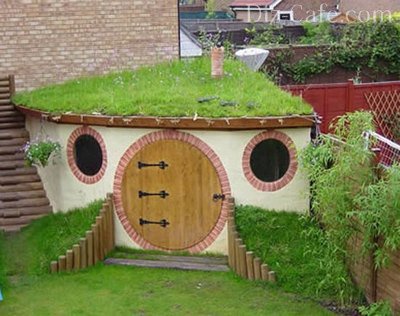
Such outbuilding with grass on the roof it looks simply fabulous. Of course, it won’t suit every style, but the idea is not bad
Designing a garden at different levels
It doesn’t matter if the area is flat, like a table; for a small garden you can always equip a small podium or even a terrace. For a site on a slope, a terrace is the most successful design technique. If the same area is considered as a plane and in the form of zones located at different levels, then the illusion of a more spacious garden will be present only in the second case.
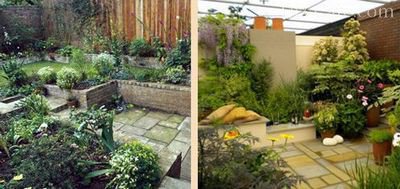
It seems that the garden, laid out at different levels, really contains even more elements, becoming more voluminous
By the way, you can create multi-level zones both in height and in depth. It is not necessary to dig into the soil for this. It is enough to apply a 3D illusion using paving areas for play area materials of different shades. Such a technique will never go unnoticed.

And this is generally a pure optical illusion, which gives the viewer a complete feeling of a depression in the center of the playing area
Another trick from the magician's arsenal
Bright handkerchiefs in the hands of an illusionist are also part of the program. Therefore, do not forget about decorative elements commensurate with the site, such as garden sculpture, dry streams, lamps, bells, attractive and other manifestations of the creativity that everyone loves so much. Don't forget about children - the flowers of life, if you have them, of course.

Openwork garden furniture in combination with lace flowers and the grace of the arch, which is located nearby, creates a feeling of airiness and does not clutter up the space
By the way, about flowers. The nuance of choosing flowers for planting in small gardens is the refusal to use plants of one variety. Choose a variety of flowers that, when you look at them, you won’t want to look for signs of a fence between them. If the use of one variety dictates the unity of the chosen style, choose rhythmic planting of plants with bright colors.

Using this example, I would like to show how a house can not compete with a garden, reducing its area, but organically merge into it, become part of it
If you don’t have enough space for a full-fledged lawn, and annoying bald spots appear in especially shaded areas, use moss. It remains green even in late autumn and will help you fight seasonal depression during the autumn leaf fall.
All that remains is to look around the area with a critical eye. Is there still room for the manifestation of our creative imagination? If the owners of even a tiny plot have the desire to make it a truly magical place, they can achieve this. Check it out by watching the video below.
Video #1:
Video #2.
Majority summer cottages They are not large in size, and therefore it is quite difficult for many to design them correctly. However, if you know the rules and adhere to them, the landscape design of a small area will turn out to be magnificent and eye-catching. Moreover, all the work will not take you much time, and the result will be excellent.
1 Landscaping of a small plot - advice from professionals
Many people think that doing all the work is quite simple. However, this is not entirely true, because with a small area, all compositions in the garden should be made as compact as possible, combining them correctly with each other. Any mistake you make will be immediately noticeable. When you are about to start creating a design, you just need to follow a few important rules:
- Tall shrubs and trees cannot be planted. Is the plot size no more than 10 acres? In this case, tall plants are contraindicated for him. And all because as they grow older they will fill the area, reducing free space. To avoid this, be sure to plant low-growing tree types. Also, do not forget about compact planting - plant them in groups, not individually.
- A blank fence can also ruin the design. And all because it will create the impression of being in a closed box, which will not bring any comfort and coziness. It is best to use an openwork metal gate and fence, decorating them with flowering vines. This is what will significantly expand the site.
- It is best to remove bulky buildings from the site. Of course, in a dacha it’s quite difficult to do without them, but a huge building and a small garden do not correspond to each other. It is best to make buildings one-story, visually “airy” and compact. You can intelligently distribute them throughout the garden, decorating neat buildings with the help of shrubs and flowering plants.
2 Site design - options and their application
In order for your site to look great, you need to properly decorate it with flowers, plants and shrubs. There are several types of design, b thanks to whom landscape design small area will strike you too and your neighbors with its beauty and originality.
- Flower garden. When planning to organize a small flower bed, place it either at the entrance or in front of the house. In all these cases, you can use old tires or flowerpots filled with soil. More than one can be placed in the center tall plant, around - a little less, then they will look harmonious.
- A secluded corner for relaxation can be created in the smallest area. For this you can use climbing roses or other types of climbing plants. We will need to fence off literally 5 meters of area, which will not be difficult. You should select a distant and inconspicuous corner, after which we mark its boundaries and place columns around the perimeter. Next, we stretch the wire and plant roses, wild grapes, and you can also install a bench for relaxation.
3 Visual expansion of the area - simple and fast
The main task of any designer is visual increase area, for which there are rules and tricks. The main emphasis is on the use of semicircular smooth lines and shapes. Sharp corners, clear geometric shapes - all this will make the landscape design of a small area dull and inconspicuous. Thanks to curving garden paths and barely visible outlines of flower beds, you can significantly expand the space on your site. Don't forget about columns, small terraces and flower arrangements.
You can completely copy the idea from magazines or the Internet, or, knowing the rules, develop the design yourself, showing a little imagination.
It is worth paying special attention to flowers and shrubs. There should not be many of them in a small area, but it is better to choose those that delight us with flowers all year round. Lilac, jasmine and rose hips are unpretentious and elegant shrubs that do not take up much space. Honeysuckle, sweet peas and grapes can be used to create a hedge. You can also decorate your site with the help of decorative and pine trees. And you can complete the composition with the help of a small pond.
Landscape design will transform a small plot of land near the house into a small masterpiece. And we will do it with our own hands. It is assumed that caring for such a garden will be simple and not require much effort.
On a small strip of land in front of the house we will add a rock garden, a small fountain, a dry stream, place a recreation area between the house and the fence, and garden lamps will add a special charm to our garden.Just before the entrance to the site, next to the car entrance (on the left), we will place our rock garden. We will create the contours of the garden from red border bricks, giving it an elegant curved shape. In the rock garden we will beautifully lay colored pebbles and plant unpretentious plants, for example.
We are planning to create a small fountain near the fence, etc. Since our area is small, our fountain will be in a semicircle.
The central composition of our landscape design in this part of the site will be a garden figurine of an elephant, from which water will flow into a fountain.
In order for our fountain to be less boring, we will add pots with aquatic plants to the elephant. We will decorate the outer part of the fountain with colored pebbles - it is these little things that create a holistic and beautiful landscape design.
In the far corner of our site we will make a dry stream. This is an excellent landscaping element for those parts of your garden where the soil is poor or clogged, or watering is inconvenient. But we are making this stream in order to interestingly place garden lamps that will illuminate this far corner of our site in the evening.
We fence the sand cushion under the dry stream with a curb stone, arrange garden figurines, lamps and mark out a place for it.
We can already admire the beautiful results of the work we did to improve the site with our own hands.
Let's use our imagination - after all, we are doing landscape design for ourselves! We made a small wooden patio, covered part of the fence with stone tiles, added garden lamps and some decorative elements.
In the evening after a hot day, our relaxation area seems like a magical paradise, although it consists of a plastic table, chairs and an umbrella. How great is the power of successful garden lighting!
In good landscape design, every corner of the garden is not a terrible “viper”, but a small pearl. Between the house and the driveway for the car, we have a small area on the right.
Here we will plant unpretentious decorative perennials, decorate our flowerbed with pebbles, garden figurines and wooden sections.
Our task was to create a cozy corner that would not require special care, looked beautiful both from the side of the house and from the street, it was beautiful both during the day and in the evening. And although this article provides an example of work landscape designers in Singapore, but the general approach and design techniques will benefit us all. I hope you enjoyed this article!
Landscaping a small plot will require careful preparation. Plant life requires sunlight, clean air, moisture and nutrients containing nitrogen, phosphorus, potassium and many other elements obtained by the plant from the soil. The lack of these nutrients slows down plant growth and causes various diseases.
The basis of any land plot makes up the soil. Nowadays in the natural environment it is very rare to find soil that is completely suitable for favorable growth plants. Most often, infertile soil is found - clay and sand without the presence of a fertile layer in them - or containing a small top layer of soil with a thickness of 5 cm to 10 cm. In this case, it is necessary to import in full or in part specially prepared soil for planting.
One of the inventions of agricultural technicians that gives us the opportunity to create the necessary top layer of soil with our own hands is soil.
Soil for the site
The soil becomes finely lumpy and granular, it contains a lot of air necessary for the root system to breathe; Due to the long-fiber structure of peat, it retains mineral fertilizers and water well.
Plants have different needs for fertile layer:
- Lawns need 15-20 cm of fertile soil, flowers about 30-40 cm, shrubs 50-60 cm, and trees up to 1 m of soil.
- The price of soil (fertile peat-soil mixture) is approximately 800 rubles/m³.
- Fertile soil - black soil - can be much cheaper.
To get a cost-effective good result, it is better to combine these two types of land. To do this, before purchasing soil, you need to do it in advance: calculate the area of the plot in front of the house, plan the planting of seedlings of trees and shrubs, areas for the lawn and flower beds, for. It is advisable to organize all the elements on paper visually into an attractive composition.
Garden fence
Landscape design on small area usually does not involve planting trees and shrubs. It is not always possible to find space for even one Christmas tree.
Unlike European countries, where doing without fences has become the norm, we need to take into account its fencing in the landscape of our yard.
A small courtyard surrounded by a low picket fence with wide gaps between the boards looks good.
Outside, behind such a fence, you can plant small Christmas trees or identical birch trees with your own hands.
Instead of a fence, evergreen shrubs boxwood and thuja are suitable for fencing the garden. A trimmed bright green boxwood hedge will reliably protect the yard from winds and snow. Boxwood is not afraid of moderate cold, and the cold-resistant thuja plant will withstand any frost.
Boxwood and thuja trees are also used for fencing 2 m high.
With such a fence, a small area in front of the house can turn into a cozy gazebo where there is little sun.
You can decorate a fence of any height with the well-known evergreen climbing plant - common ivy.
- Ivy is unpretentious and only needs a little cover of its roots in winter.
- A hydrangea planted near the fence will become a good backdrop for the entire yard.
- This amazing shrub blooms for a very long time - from mid-summer to late autumn.
- And the most beautiful hedges are created by climbing roses.
A neat wooden fence planted with climbing roses of winter-hardy varieties is a wonderful landscape from which you can’t take your eyes off.
Modern varieties of climbing roses may not need shelter in winter or make do with non-woven material in cold regions. From one small cutting, in a few years you can grow a huge, luxurious rose bush. Hiding the fence and surrounding the lawn, colorful rose bushes of different varieties are sometimes enough to create a landscape design in front of the house.
A good solution for a small area of the yard would be to create a vertical garden.
Decorating the walls of the house with beautiful vines, flowers and plants arranged small terraces on retaining walls, in raised flower beds, along the walls of the house - all this will create the necessary abundance of greenery. Petunia, traditionally used for garden decoration, planted in pots, in hanging baskets, in all kinds of containers, can be planted in a so-called vertical flower bed.

Vertical flower bed for petunia
To create a vertical flower bed, you first need to prepare the frame. It can be made from metal or plastic mesh with large cells. For the frame, we twist the mesh into a cylinder of the appropriate diameter suitable for the pot. We wrap the inside of the cylinder with agrofilm and secure it well to the mesh. Before pouring soil into the frame, insert a plastic tube inside the prepared cylinder. It is needed for watering (a plumbing pipe will do). We drill holes in the pipe and cover the bottom with clay-cement mortar. Water will be poured into the pipe, and the soil will be evenly moistened through the holes. To prevent the holes from becoming clogged with soil, wrap the outside of the pipe with polyethylene and puncture holes in it corresponding to the holes of the pipe. Then, evenly moistening the soil, we fill the entire frame with it. Using a utility knife, you need to cut holes in the frame film in the form of pluses. We plant petunia seedlings in these holes and along the top of the frame. When the seedlings grow, it will be a gorgeous vertical flower bed.
Decorating the walls of the house with vines
Clematis is one of the most beautiful vines with huge flowers and has a rich variety of varieties. This vine is ideal for decorating the walls of your home. Clematis will require a simple upward rope support for its growth. When planting clematis, remember that it must be planted in a deep and wide hole measuring 60x60 cm. Areas with high groundwater levels are not suitable for planting. It is necessary to provide the plant with good drainage by pouring 10-15 cm of coarse sand or gravel into the bottom of the hole so that the roots do not rot. The abundance of flowers on the vine, their brightness and colorfulness depend on how the root system feels. A clematis bush can grow in one place for 40 years and always delight with its flowers. This vine blooms from early spring to late autumn. Clematis, which needs to grow from shade to sun, does very well next to lawn grass.

Green lawn
A green front lawn is the best foundation for any landscape. The grass on the lawn serves as a wonderful place for relaxing with family and friends, for children's walks and games. You can create a lawn with your own hands by sowing the lawn with seeds. It will cost much less than buying a ready-made rolled lawn. But in this case, it will be possible to actively use the lawn only next year.
When purchasing a lawn, it is advisable to focus on varieties that are not very demanding in terms of care. The choice can be made from parterre, Moorish and sports types.
- Parterre lawn is the most decorative of them, it is very resistant to trampling, but requires more maintenance costs.
- The Moorish lawn combines simple meadow plants.
This is the most unpretentious type of decorative lawn. Sports turf grass also has increased resistance to trampling, but requires frequent feeding.
To a greater or lesser extent, all lawns need care. To free the lawn from debris and remove the felt layer from the surface of the soil, comb it out with a fan rake. Over time, the roots of the lawn grow greatly, this makes it difficult to saturate the underground part of the roots with oxygen, so aeration is carried out - punctures in the turf layer with an aerator.
If the lawn is small, you can use an ordinary garden fork for aeration.
The lawn is regularly watered, mowed, and fed with fertilizers enriched with nitrogen, potassium, and phosphorus.
It is better not to plant flowers on the lawn of a small yard in special holes. They can be planted on both sides of the lawn from the very threshold of the house to the alpine hill, which is best placed in front of the house. You can choose certain varieties of flowers that are most suitable for a landscape with a lawn. These are mostly bulbous - tulips, daffodils, lilies. Better yet, plant your favorite flowers.
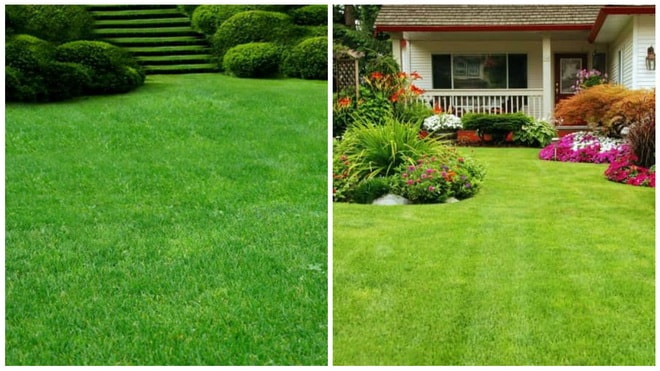
Landscape design style
Your garden knows no limitations, but since we are talking about design, there must be organization in planting flowers. The point of landscape design is to create a composition in a certain style from landscape elements. You can create a composition from beautifully planted plants, paved paths, lawns, alpine slides, fountains, gazebos, arches, borders, hedges and garden decorations. By choosing any elements you like, you can create your own individual style.
For a small yard the best option will create a high-tech design that is characterized by modernity, pragmatism and individuality. In this style, you can show your wildest fantasies: arrange unusual slides from boulders, choose interesting combinations of plants and garden decorations, make a path from natural stones.
Since it is not possible to create a classic alpine slide with large stones in a small area, you can make it with your own hands from small stones with some compact plants that do not require serious care. Small coniferous plants such as mountain pine, fir, different kinds oil. For the slide, you can use small interesting stones of different formats and different textures. For example, beautifully laid flat stones combined with dwarf plants will create a Japanese theme, while rocky ones combined with mountain iris and violets will give the impression of a mountain slope. This impression will be enhanced if you plant Cossack juniper next to such a hill, whose usual habitat is rocky mountains.
A romantic free style, in which there is a feeling of harmony and romance, is also suitable for a cozy courtyard. This style involves a lot of flowers and climbing plants. There are no strict boundaries in it. You can create a rose garden from several rose bushes and choose plants that look good next to them - sage, cloves, various types of hosta. Standard roses planted in flowerpots with a volume of more than 30 liters look good against the background of the lawn. Weeping standard roses, the garlands of which hang down to the ground, make an indelible impression. A standard rose is a technique of garden art; it is a rose grown in the form of a tree with a crown of flowers. It is good to place it near benches and gazebos. In winter, it is brought into the basement with a temperature of +1...+3°C or covered like ordinary roses, turning the pot over to the ground.
The remaining design styles - classic, romantic, oriental, modern, baroque, alpine, etc. (there are more than 20 in total) - can only be implemented on large garden plots ranging in size from 6-8 acres. High-tech style is characterized by unusual designs and accessories. Garden decor in the form of a variety of lamps, interesting figures of animals and birds, colored pebbles and sand for paths, and unusual lighting of paths will help create the desired mood in the garden.
Professionals from specialized design studios can always offer a variety of ready-made landscape compositions and make them according to your order. But landscape design created with your own hands, daily changes in the growth and flowering of the garden will become a source of a brighter feeling of life as continuous novelty.









